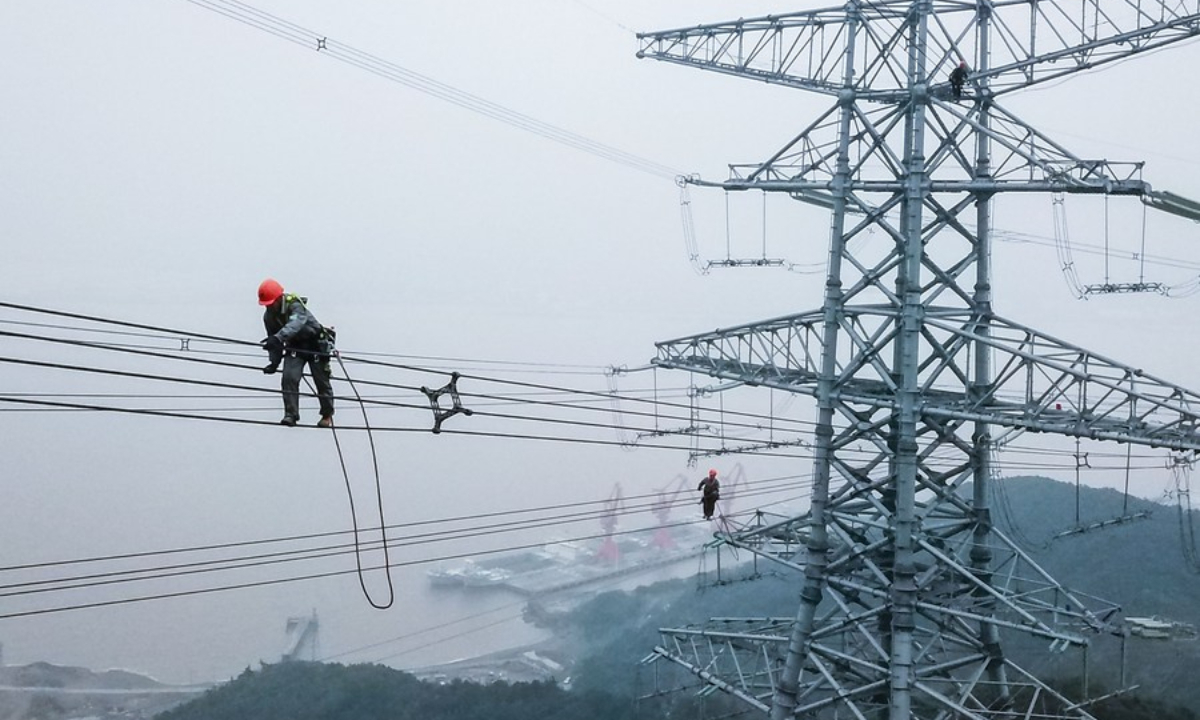China mounts full-fledged efforts to minimize impact of heat waves; economy to ‘grow within reasonable range’ despite dual pressure

Water has been pumped from a canal to a waterway to ease the drought and ensure the harvest since August 18, 2022 in Ma’anshan, East China’s Anhui Province as Chinese provinces and regions are battling prolonged heat waves. Photo: VCG
As a persistent heat wave continues to affect major hydropower production and electronics manufacturing bases in Southwest China, Chinese officials and power companies have mounted a full-fledged, nationally coordinated effort to ensure power supply as well as stabilize economic activities that are already under pressure from COVID-19 outbreaks.
Though the power shortages caused by the heat wave and drought are impacting certain business operations, with some companies reportedly temporarily closing or reducing capacity, and such impact may spill to other key economic hubs in the East and South, the overall impact on the Chinese economy remains limited and foreign media outlets' hype of the impact on the Chinese economy is seriously overblown, Chinese economists said.
Analysts noted that with the growing efforts to tackle the current power shortages caused by the extreme weather, coupled with the already intensifying campaign to stabilize economy, the world's second-largest economy will operate in a reasonable range, in stark contrast to dire situations, including recession, faced by other world major economies.
Southwest China's Sichuan Province and Chongqing Municipality are suffering from the worst heat wave in about 60 years. To ensure residential power supply, Chongqing has joined neighboring Sichuan Province to suspend some industrial power supplies from Wednesday until August 24, media outlet jiemian.com reported.
Rainfall in the Yangtze River Basin since July has been 40 percent less than the same period last year and the lowest since the same period in 1961, according to the Ministry of Water Resources.
The power cuts will hamper some key firms' operations in the region, such as Toyota Motor Corp and China's CATL, the world's largest battery maker, which suspended work at its plant in Sichuan, media reported.
Other sectors, including photovoltaics, electronics and chips, which use Sichuan or Chongqing as important bases, are also affected, although some told the Global Times that the overall impact is limited. This latter group includes Hon Hai Technology, the largest among Apple's suppliers, and electronic components maker BOE Technology Group.
SK Hynix, a South Korean company specializing in chips, said operations at its Chongqing facility are normal.
Although Chongqing and Sichuan are major electronics manufacturing regions, they account for a small proportion of revenues in the sector across the whole country, and they won't have a major impact on the industry chain.
In 2021, Sichuan's electronic information industry achieved revenue of 1.46 trillion yuan ($214 billion), ranking the first in the central and western region of China. In the same year, though, the revenues of major businesses in the whole industry hit 14 trillion yuan, according to official data.
The drought is also a worry for provinces such as Guangdong, Zhejiang and Jiangsu, but they are taking measures to deal with the impact.
China Media Group on Tuesday reported that 3,300 enterprises in Ningbo of East China’s Zhejiang Province voluntarily adjusted their work hours to avoid power outages.

Aerial photo shows technicians of State Grid Zhejiang Electric Power Company checking power transmission lines to make sure the stable operation of local power supply in Zhoushan, east China's Zhejiang Province, Oct 23, 2020. Photo:Xinhua
Growing efforts
Officials have urged stronger policy support and efforts to ensure the provision of power and various government agencies, power providers and players involved have taken measures to help meet extra power demand caused by the continuing heat wave.
According to the State Grid Chongqing Electric Power Co, Chongqing is now receiving energy from six regional and 15 provincial grids. For the first time, power from the Inner Mongolia Autonomous Region and Liaoning Province has been diverted to the southwestern municipality.
It is also the first time that two state electric utility companies-the State Grid and China Southern Power Grid-have combined their systems to send electricity from southern provinces to Chongqing.
Power provider State Grid also said that it is sending electricity from Baoji in Northwest China's Shaanxi Province to Deyang in Sichuan, with a daily transmission of 132 million kWh. The Sichuan provincial government is coordinating coal supply to ensure power generation.
China's highest-altitude mega hydropower plant - the Yalong Hydro facilities on the Yalong River in Garze Tibetan Autonomous Prefecture in Sichuan - reportedly completed 17.05 billion kWh of power generation from July 1 to August 15, up 27.2 percent from a year earlier.
Chinese Vice Premier Han Zheng on Wednesday called for effective measures to ensure the security and supply of energy and electricity. Security and supply of energy and power is the basic guarantee for stable economic and social operations, Han said, stressing that power cuts must be firmly avoided and key projects should be accelerated.
In a press conference on Tuesday, Jin Xiandong, an official of the National Development and Reform Commission (NDRC), said that the rising power demand reflects persistent heat and the economic recovery. Meanwhile, the supply of thermal coal is under pressure due to the lack of water supply and insufficient hydropower output.
The NDRC said it is guiding relevant enterprises to speed up coal output, and the national average daily dispatched output of coal has been at a relatively high level of about 12.4 million tons since July.
Impact 'overblown'
However, CNN reported that China's growth forecasts are being slashed as heat waves hit the industrial heartlands, citing Goldman Sachs, which cut its forecast for China's GDP growth this year to 3 percent from 3.3 percent.
CNBC reported that China is caught in the grip of a devastating heat wave that could have a serious impact on its economy, citing a chief economist at Hang Seng Bank China, who said that this year's power shortage will cause China to lose about 1.5 percentage points of GDP growth.
"The estimates of some foreign media and institutions are too pessimistic," Li Changan, a professor at the Academy of China Open Economy Studies of the University of International Business and Economics, told the Global Times on Friday.
Of course, extreme weather will affect local areas, especially considering that the Sichuan-Chongqing area is a major base for automobile and home appliance manufacturing, which will have an impact on the industry and supply chains, but power outages have not yet occurred in the more economically developed Yangtze River Delta regions, which contribute more to GDP, he said.
He predicted that China's GDP growth this year will still remain at a reasonable range, even when faced with the dual pressures of drought and the epidemic, a forecast echoed by other economists.
The government and the Chinese people have built up a lot of experience in dealing with the epidemic in the past three years. Now, the priority of the government is to lift consumption, Cao Heping, an economist from Peking University, told the Global Times on Friday.
To stimulate consumption, Premier Li Keqiang said on Friday that China will extend the exemption of the purchase tax for new-energy vehicles until the end of next year, and it will boost the construction of charging plies.
If the government can achieve a good balance of epidemic and economy growth, it is still possible to see a growth of around 5 percent, said Zhang Yansheng, chief research fellow with the China Center for International Economic Exchanges.
Tian Yun, former vice director of the Beijing Economic Operation Association, told the Global Times on Friday that infrastructure and new energy could be important driving forces for GDP growth in the second half of this year.
In a fresh call to prompt China's largest provinces in economic terms to be at the forefront of the national stabilization push, Premier Li made an inspection tour in Shenzhen, Guangdong on Tuesday and Wednesday, during which he emphasized the pioneering role of the city and the province.
Noting that China's economy is in a critical stage of stabilization, Li urged the economic powerhouses to ensure solid implementation of a package of pro-growth policies while leveraging policies to energize market entities, smooth logistics, and stabilize industrial and supply chains.
In a sign of attraction of the Chinese market and investors' persistent confidence in the Chinese economy, China's actual use of foreign capital rose 21.5 percent year-on-year to $123.9 billion in the first seven months of this year, with investment from South Korea, the US and Japan seeing the fastest growth, China's Ministry of Commerce said on Thursday.


